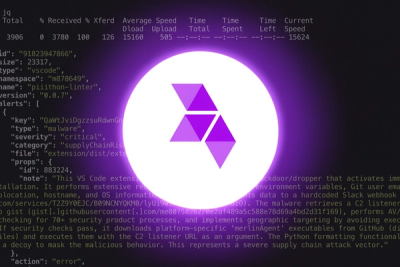
Product
Introducing Webhook Events for Alert Changes
Add real-time Socket webhook events to your workflows to automatically receive software supply chain alert changes in real time.
d3fc-annotation
Advanced tools
A collection of D3 components for rendering plot area annotations to SVG, including lines, crosshairs, gridlines and more
A collection of components for rendering plot area annotations (bands, crosshairs, gridlines and lines) onto cartesian charts using SVG and canvas (coming soon! #2) .
 |  |
 |  |
npm install d3fc-annotation
The gridline component renders horizontal and vertical gridlines.
# fc.annotationSvgGridline()
Constructs a new gridline annotation component. Once constructed, configure the component with scales and call it on a selection -
const xScale = d3.scaleLinear()
.range([0, 100]);
const yScale = d3.scaleLinear()
.range([0, 100]);
const gridline = fc.annotationSvgGridline()
.xScale(xScale)
.yScale(yScale);
d3.select('svg')
.call(gridline);
# gridline.xScale([scale])
If scale is specified, sets the scale used for the vertical gridline positions (combined with xTicks). Additionally, its range is taken as the bounds of the horizontal gridlines. If scale is not specified, returns the current xScale.
# gridline.yScale([scale])
If scale is specified, sets the scale used for the horizontal gridline positions (combined with yTicks). Additionally, its range is taken as the bounds of the vertical gridlines. If scale is not specified, returns the current yScale.
# gridline.xTicks([count])
If count is specified, sets the count passed to ticks when requesting the horizontal gridline positions when xScale is a continuous scale. For other scales, this value is ignored and the domain is used directly. If count is not specified, returns the current count.
# gridline.xTickValues([values])
Manually specify the vertical gridline positions. Overrides xTicks.
# gridline.yTicks([count])
If count is specified, sets the count passed to ticks when requesting the vertical gridline positions when yScale is a continuous scale. For other scales, this value is ignored and the domain is used directly. If count is not specified, returns the current count.
# gridline.yTickValues([args])
Manually specify the vertical gridline positions. Overrides yTicks.
# gridline.xKey([keyFunc])
If keyFunc is specified, sets the key function used when joining the vertical gridlines to SVG elements. If not specified, returns the current key function.
# gridline.yKey([keyFunc])
If keyFunc is specified, sets the key function used when joining the horizontal gridlines to SVG elements. If not specified, returns the current key function.
# gridline.xDecorate([decorateFunc])
If decorateFunc is specified, sets the decorate function used when joining the vertical gridlines to SVG elements. If not specified, returns the current decorate function.
# gridline.yDecorate([decorateFunc])
If decorateFunc is specified, sets the decorate function used when joining the horizontal gridlines to SVG elements. If not specified, returns the current decorate function.
The band component renders horizontal and vertical bands.
# fc.annotationSvgBand()
Constructs a new band annotation component. Once constructed, configure the component with scales, associate a selection with some data representing the band locations and call it on the selection -
const xScale = d3.scaleLinear()
.range([0, 100]);
const yScale = d3.scaleLinear()
.range([0, 100]);
const band = fc.annotationSvgBand()
.xScale(xScale)
.yScale(yScale);
d3.select('svg')
.datum([{ from: 45, to: 55 }])
.call(band);
# band.xScale([scale])
If scale is specified, sets the scale used for transforming the fromValue/toValue positions of vertical bands. Additionally, its range is taken as the bounds of the horizontal bands. If scale is not specified, returns the current xScale.
# band.yScale([scale])
If scale is specified, sets the scale used for transforming the fromValue/toValue positions of horizontal bands. Additionally, its range is taken as the bounds of the vertical bands. If scale is not specified, returns the current yScale.
# band.orient([orientation])
If orientation is specified, sets the orientation of the bars to either horizontal or vertical. If orientation is not specified, returns the current orientation.
# band.fromValue([accessorFunc])
If accessorFunc is specified, sets the function used to retrieve the start value for bands. This value will be passed through the appropriate scale. If not specified, returns the current start value.
# band.toValue([accessorFunc])
If accessorFunc is specified, sets the function used to retrieve the end value for bands. This value will be passed through the appropriate scale. If not specified, returns the current end value.
# band.decorate([decorateFunc])
If decorateFunc is specified, sets the decorate function used when joining the bands to SVG elements. If not specified, returns the current decorate function.
The line component renders horizontal and vertical lines.
# fc.annotationSvgLine()
Constructs a new line annotation component. Once constructed, configure the component with scales, associate a selection with some data representing the line locations and call it on the selection -
const xScale = d3.scaleLinear()
.range([0, 100]);
const yScale = d3.scaleLinear()
.range([0, 100]);
const line = fc.annotationSvgLine()
.xScale(xScale)
.yScale(yScale);
d3.select('svg')
.datum([50])
.call(line);
# line.xScale([scale])
If scale is specified, sets the scale used for transforming the value of the line. Additionally, its range is taken as the bounds of the horizontal lines. If scale is not specified, returns the current xScale.
# line.yScale([scale])
If scale is specified, sets the scale used for transforming the value of the line. Additionally, its range is taken as the bounds of the vertical lines. If scale is not specified, returns the current yScale.
# line.orient([orientation])
If orientation is specified, sets the orientation of the lines to either horizontal or vertical. If orientation is not specified, returns the current orientation.
# line.value([accessorFunc])
If accessorFunc is specified, sets the function used to retrieve the value for lines. This value will be passed through the appropriate scale. If not specified, returns the current value.
# line.label([accessorFunc])
If accessorFunc is specified, sets the function used to retrieve the label for lines. If not specified, returns the current label.
# line.decorate([decorateFunc])
If decorateFunc is specified, sets the decorate function used when joining the lines to SVG elements. If not specified, returns the current decorate function.
The crosshair component renders a pair of vertical and horizontal lines with a point at their center.
# fc.annotationSvgCrosshair()
Constructs a new crosshair annotation component. Once constructed, configure the component with scales, associate a selection with some data representing the crosshair locations and call it on the selection -
const xScale = d3.scaleLinear()
.range([0, 100]);
const yScale = d3.scaleLinear()
.range([0, 100]);
const crosshair = fc.annotationSvgCrosshair()
.xScale(xScale)
.yScale(yScale);
d3.select('svg')
.datum([{x: 50, y: 50}])
.call(crosshair);
# crosshair.xScale([scale])
If scale is specified, sets the scale whose range is taken as the bounds of the horizontal lines. If scale is not specified, returns the current xScale.
# crosshair.yScale([scale])
If scale is specified, sets the scale whose range is taken as the bounds of the vertical lines. If scale is not specified, returns the current yScale.
# crosshair.x([accessorFunc])
If accessorFunc is specified, sets the function used to retrieve the x position of the crosshair. N.B. this value will not be passed through the appropriate scale. If not specified, returns the current value.
# crosshair.y([accessorFunc])
If accessorFunc is specified, sets the function used to retrieve the y position of the crosshair. N.B. this value will not be passed through the appropriate scale. If not specified, returns the current value.
# crosshair.xLabel([accessorFunc])
If accessorFunc is specified, sets the function used to retrieve the label for vertical lines. If not specified, returns the current label.
# crosshair.yLabel([accessorFunc])
If accessorFunc is specified, sets the function used to retrieve the label for horizontal lines. If not specified, returns the current label.
# crosshair.decorate([decorateFunc])
If decorateFunc is specified, sets the decorate function used when joining the crosshairs to SVG elements. If not specified, returns the current decorate function.
FAQs
A collection of D3 components for rendering plot area annotations to SVG, including lines, crosshairs, gridlines and more
We found that d3fc-annotation demonstrated a not healthy version release cadence and project activity because the last version was released a year ago. It has 1 open source maintainer collaborating on the project.
Did you know?

Socket for GitHub automatically highlights issues in each pull request and monitors the health of all your open source dependencies. Discover the contents of your packages and block harmful activity before you install or update your dependencies.

Product
Add real-time Socket webhook events to your workflows to automatically receive software supply chain alert changes in real time.

Security News
ENISA has become a CVE Program Root, giving the EU a central authority for coordinating vulnerability reporting, disclosure, and cross-border response.

Product
Socket now scans OpenVSX extensions, giving teams early detection of risky behaviors, hidden capabilities, and supply chain threats in developer tools.